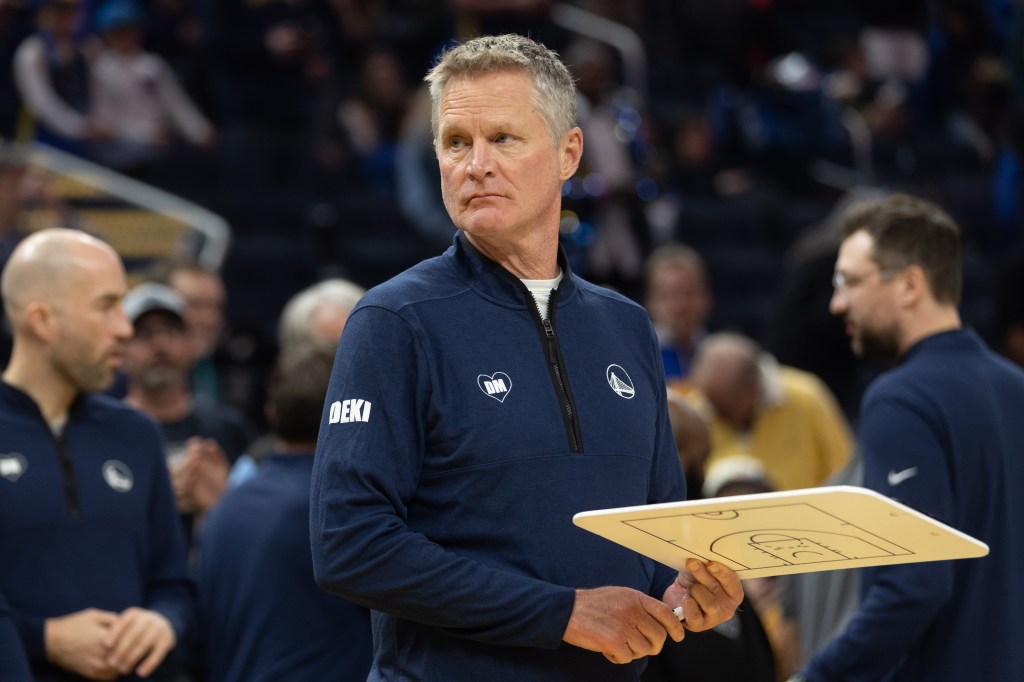Stephen Curry popped open off a screen from Jonathan Kuminga and drilled a double-pump leaning 3 and followed up with another one a few possessions later. Buddy Hield shot without conscious or remorse as he knocked down six of his seven attempts from 3. DeAnthony Melton and Kuminga scorched the Golden 1 Center floor with a combined eight 3s. Bombs over Sacramento.
The Warriors’ win Wednesday over the Kings is exactly what head coach Steve Kerr envisioned offensively this season: a fast-paced team that can light up the nets — and the scoreboard — from deep.
After losing Klay Thompson to the Dallas Mavericks in free agency during the offseason, Golden State had to compensate for a loss of spacing and auxiliary scoring. Given the circumstances, the approach makes sense.
“We’re not a team that gets to the free-throw line much. It would be hard for us to win a lot of games unless we shoot a high volume of 3s,” Kerr told reporters after the game. “What I like about this team, even though we lost Klay, we have more shooting depth. We have more guys that can step in and make 3s one night to the next.”
It’s fair to say that this approach isn’t anything new, and it’s a continuation of a trend. Last season, the Warriors ranked fourth in the league in 3-pointers attempted per game (38.9) and second in 3s made (14.8). In the 2022-23 NBA season, the Warriors led the league in 3s attempted (43.2) and made (16.6), and ranked second in percentage (38.5).
The Warriors took 100 shots from beyond the arc over their first two preseason games, realizing that they have to lean into the shot if they want to win and be a dark horse in a stacked Western Conference.
Here are some pros and cons to this approach:
Pro: Buddy Splash
The Warriors acquired Buddy Hield via sign-and-trade in part of the six-team deal that include Kyle Anderson and facilitated Thompson going to Dallas. The 31-year-old sharpshooter has hit 200-plus 3s in six seasons, and has been one of the top 3-point shooters in the league in volume and makes in multiple seasons.
Hield would feast in a Warriors offense that consists of coming off various curls and pindowns. When paired with Curry, Hield could thrive with clean looks due to the gravity that Curry still commands.
The concern with Hield lineups is defense, especially since the Warriors are a small team. If he can defend to the point where he can remain on the floor or the Warriors surround him with lineup combinations that mask those deficiencies, those issues would be less of a concern.
Con: Turning ‘non-shooters’ into efficient shooters
Hield is the only proven shooter on the roster not named Curry. With that being said, there will be lineups throughout the season that have no spacing but thrive on defense and in transition. Increasing attempts from deep will require some of the players in these lineups to increase both their volume and efficiency from 3.
Draymond Green recorded the highest 3-point percentage of his career last season at 39.5 percent. He attempted an average of 2.3 3s per game. Since he isn’t known as a shooter, defenses are prone to sag off him and concede those open looks. I expect nothing less from opposing defenses. They will continue to leave Green open. What would Green’s percentages look like if he were to take three more attempts per game this season? How many 3s can he make on anywhere between four and five attempts per game? One positive is he is confident to take them in the flow of the offense, and has been working on shooting from behind the arc.
Kuminga can put pressure on the rim, draw contact and finish. What will really change the dynamic of the Warriors offense, however, is whether or not he can consistently knock down 3-point shots when they’re open. Last season, Kuminga averaged 2.2 attempts on 32.1 percent shooting. He will have to increase his volume to at least four attempts and make them at a higher rate. If he can make 3s consistently, he can play in lineups with little spacing and help draw defenders.
In Wednesday’s game against the Kings, Kuminga showed that he had the ability to shoot and make 3s at a higher clip when he shot 4-for-7 from 3.
Green and Kuminga aren’t alone. For this to work, it will take a collective effort to help space the floor.

Pro: Elements of surprise
While Curry and Hield are the only certified shooters on the roster, there are other players who could step up and show that they too have a respectable shot.
Melton is known for his hard-nosed defense. Offensively, he has averaged double-digit scoring each of the last three years and is a career 37 percent 3-point shooter. In addition to Melton, Lindy Waters III is another wing that can provide auxiliary scoring from deep. He came up clutch in the Warriors’ preseason opener against the Los Angeles Clippers, knocking down a game-winning 3. Waters finds himself in the same situation that he had in Oklahoma City — being buried in the rotation because of depth and talent. However, with his shotmaking (43.5 percent from 3 last season), Waters has an opportunity to grab a spot on this roster.

















































